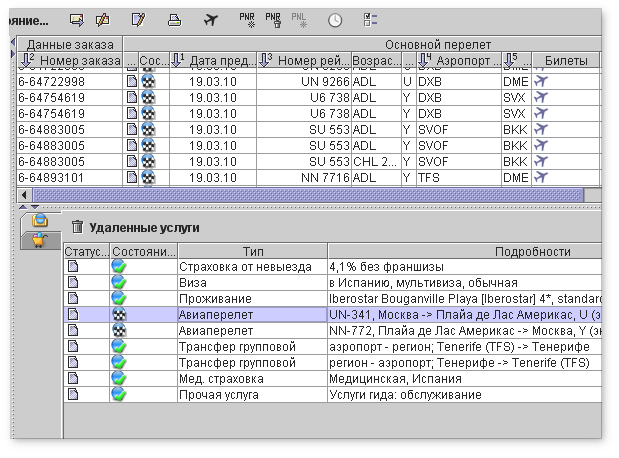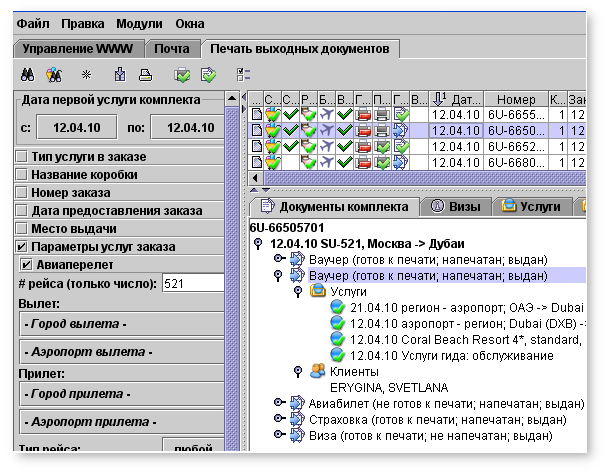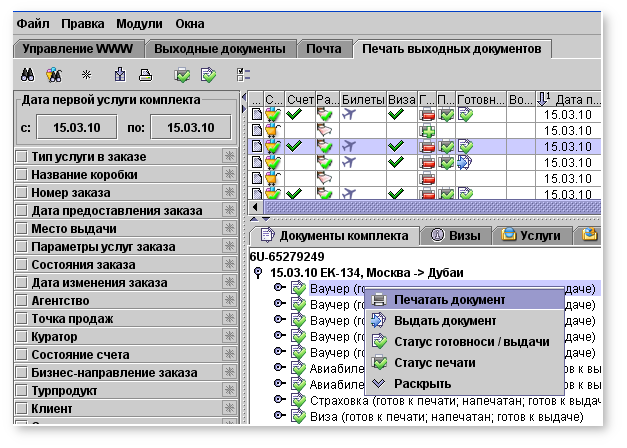Sergey Scheglov Portfolio
Project: travel erp system
Enhanced B2B travel system enabled efficient travel packages and travel documents management. Automated internal processes to reduce costs and improve performance.
Background
This project aimed to replace an outdated booking management platform with a modern ERP system tailored for the travel industry. The ERP was designed to support B2B operations for travel agencies, improve internal efficiency, and integrate all business-critical processes — from booking and visa handling to logistics, document generation, and external supplier connections. The system also included a multi-service inventory covering hotels, flights, transfers, visas, insurance, and excursions.
Objectives
- Centralize and automate the full sales and service cycle for B2B travel products.
- Reduce operational overhead and minimize human error through workflow automation.
- Automating bookings with external providers and visa data exchange with consulates.
- Organizing logistics for travel documents.
- Supporting account managers with customer account management functionalities (CRM).
- Provide consistent, structured data across departments and locations.
- Support scalability as the company expanded offerings and regional presence.
Challenges
- Legacy systems with limited interoperability.
- Lack of automated integrations with suppliers and consulates.
- Difficulties in requirements gathering due to undocumented internal workflows.
- High complexity of document-based services such as visas and vouchers.
- Tight deadlines aligned with seasonal travel demand.
My Role
I joined the project as Project Manager, later transitioning into the Product Owner role. While the ERP was initially developed under a Waterfall methodology, I introduced Agile practices in several modules to improve responsiveness and collaboration. I was responsible for:
- Functional analysis and requirement definition;
- Stakeholder engagement with internal departments and branch offices;
- Roadmap planning, backlog management, and release coordination;
- Cross-functional team collaboration (developers, designers, visa and logistics teams);
- Running demos, refining prototypes, and collecting feedback from real users.
Key Functionalities / Modules
- Inventory Management – Centralized catalog of travel services: hotels, flights, transfers, insurance, visas, excursions.
- Booking Module – Support for complex package bookings, modifications, and document generation.
- Visa Management Subsystem (see Visa Management Subsystem Project) – Full-cycle automation of visa workflows, including document checklists, status tracking, barcode-based logistics, and consulate integrations.
- Logistics & Document Handling – Document packaging, internal routing, courier tracking, and physical workflow management.
- CRM Integration – Tools for managing client relationships and personalized B2C communication.
- Financial Module – Invoicing, payments, and accounting process automation.
- External Supplier Integrations – XML/API and file-based connections with 15+ partners.
- Analytics & Reporting – External BI system for decision-making.
Approach
The project followed a hybrid methodology — with long-term planning via Waterfall, and iterative Agile delivery introduced at the module level.
For modules like visa processing, booking, and logistics, I introduced:
For modules like visa processing, booking, and logistics, I introduced:
- Prototyping to validate functionality and user experience early;
- Short feedback loops with internal users and department heads;
- Frequent demos to internal stakeholders for early validation;
- Progressive release planning, aligned with the company’s seasonal peaks.
Methodology and Tools
- Project Methodology: Hybrid — Waterfall planning with Agile module-level execution
- Backlog and Planning: Internal ERP task tracker (initially), later Jira for backlog grooming, sprint tracking, and velocity measurement
- Modeling & Specifications:
- Rational Rose / Enterprise Architect for process and data modeling
- IDEF1 and class diagrams for data models
- IDEF0 and DFD for function modeling
- UML sequence and activity diagrams for dynamic behavior modeling
- Project Tracking: ProjectLibre for roadmap and milestone planning
- Cross-functional collaboration: Product, development, design, finance, visa/logistics, and support teams
- Prototyping tools: For early UX validation
- ERP toolkit: Used internal modules for Orders, Inventory, Document Handling, and Logistics
- Analytics and metrics:
- Google Analytics to track user behavior across customer-facing interfaces, enabling us to optimize usability
- Oracle BI (OLAP) to run multidimensional reports and perform ad hoc analysis on operational KPIs
Metrics and KPIs
Business Performance Metrics
Operational Efficiency Metrics
- Revenue (total and segmented by product category or destination)
- Revenue per client and average booking value
- Operational margin, tracked to evaluate profitability after automation and efficiency improvements
- Adoption rate, especially in early-stage rollouts
- Client retention rate, as a signal of loyalty and service reliability
- Client (agency) base evolution – tracking the number of B2B partners and their booking activity over time (new vs. returning agencies)
Operational Efficiency Metrics
- Impact of Process Automation, measuring how automation (e.g. booking data delivery, invoice dispatch) reduced processing time and manual workload across high-volume tasks
- Search response time, for critical operations in both front-office and back-office interfaces, tracked as a key factor affecting usability, adoption, and user satisfaction
- Average processing time per operation
- Complaint frequency from clients (agencies), categorized by type
- Delivery velocity, mapped against planned milestones
- System uptime and error frequency, particularly in high-season periods
- Integration success rate, especially for external suppliers (XML/API)
- Time-to-resolution for bugs and system incidents, used to optimize team workflows
- Number of iterations to stability, used to assess complexity and developer readiness
- Bugs per release, classified by severity, supporting QA efficiency and future release forecasting
- Regression incidents, particularly after changes to barcode templates or external integrations, tracked to reduce rework and instability
Results
- Developed a top market solution that remained in use for 18 years.
- Increased service department productivity by 200% over 4 years by optimizing and automating workflows.
- Built an API for marketplace integration and XML connections with 15+ suppliers.
- Created a logistics system for travel document delivery.
- Integrated CRM for B2C sales.
Lessons Learned
- Experienced developers are key to project success.
- Agile methodology may have been more effective.
- Stakeholder engagement throughout the project is paramount.
Galery



Contacts
© 2024 All rights reserved.

 .
.